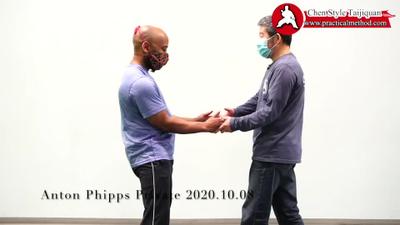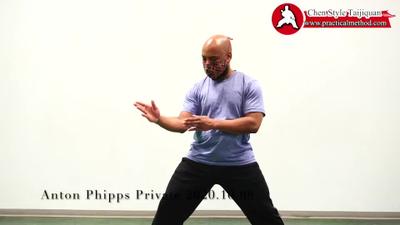Master Chen Zhonghua’s Private lesson with Anton Phipps on Oct. 8, 2020.
In this lesson Master Chen Zhonghua taught Phipps how to isolate power from the kua and use it like a hammer to power the forearm in Twisting the Towel.
Presenter: Chen Zhonghua Length: 57 min. In: English Year: 2020 Difficulty:1/5 At:Edmonton Chen Zhonghua Taiji Academy





{ 1 comment… read it below or add one }
Producing Power with Conversion
While showing Master Chen my foundation exercise twisting the towel for review and correction, I was told that though the outward appearance might seem correct there was a problem. Master Chen described:
“Your arms are correct but you did not produce power with a conversion. Every move has to go through a conversion, otherwise we say you are moving. (…) Do you understand?”
With this explanation, and having never herd the term I had to answer no. Thankfully he kindly elaborated for me:
“(…) I am using a technical term, but it is a Taiji term. So, when you hold a nail and try and put it into the wall that is called level one with no conversion. Conversion is you are actually holding the nail, [and hitting] with a hammer. The hammer is not the nail, the hammer is not your hand. So when you are using the nail itself to go into the wall, and you hold the nail with your hand to [push it] into the wall, that’s level one. Conversion is level two.”
In this description I was beginning to understand that when there is conversion, there are two separate things one acting upon another. (I will have to verify my understanding with Master Chen so just follow his quotations, and full explanation in the video.) Master Chen further clarified:
“When you hold the nail you become the nail, you become part of it. The hammer is not part of the nail. (…) So the hammer and nail become yin and yang. (…)”
After this explanation, Master Chen had me assume a light horse stance, so that I could get more movement out of my kua, and completely relax my arms so he could guide my movement. Once I was in position he said:
“So now I do the job. I’m holding you in place. (…) So now I use my hand to shoot [the arm out]. (…) This is what we need to do , and when that happens you have a converted power. It is my power converted into [this arm].”
With this demonstration, I was shown that another part of the body, in this case the lower body must be the hammer and my forearm is the nail. Only using proper Taiji could this be physically applied. This tied into the final part of Master Chen’s verbal explanation on the matter:
“So there is a rule in Taiji: Taiji is Yin and Yang. It means Yin is Yin, and Yang is Yang. Yin will never be Yang. It means Yin itself cannot do anything to itself. So this [arm] is itself, there has to be another body part that is not linked to it. (…) Anything touching [for example chest and arms] are connected, but this [kua] is not connected. So you use the kua to hit here [the arm].”
This final part made the concept clear, but making the body adhere to the principle is very difficult. The rest of the lesson I received corrections on this principle, and some others to help my body begin to operate according to the principles.
It is as Master Chen explained to me in the past:
Doing techniques correctly is like having a wrench on a rusty bolt. At first nothing will move, but you are using it correctly. If you take the wrench off the bolt it will move but nothing is being accomplished. When the wrench is on the bolt eventually the bolt will loosen up and start to turn. This is just like the body when applying the Taiji principles. Eventually it will open up and be able to move properly. (Paraphrasing from memory.)